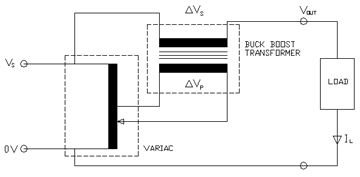The Buck-Boost system is a means of connecting a transformer to add or subtract a voltage to the existing supply voltage. The simplest form of Buck-Boost transformer is the autotransformer. Here a section of the winding is used to increase or decrease the output voltage in relation to the input voltage. The adjusting part of the wind is the “over wind” the rest of the coil is the “common wind”.
A more complex form of this is where the voltage being added to or subtracted from is different to the reference input voltage. In such a case an isolation transformer is used to separate the common part of the autotransformer winding from the over wind.
Consider the following circuit.

Here a variable transformer is used to provide an adjustable input to the primary of the Buck-Boost transformer. One end of the primary of the buck-boost transformer is connected to the centre tap of the variable transformer, the other end to the adjustable wiper. In this way the primary voltage of the transformer ΔVP can now be varied from -VS/2 to +VS/2. The secondary of the buck boost transformer ΔVS will therefore vary...
from  to
to 
 to
to 
Where NS and NP are the secondary and primary turns respectively.
Connecting one end of the secondary coil to the main supply voltage VS will result in an output of the Buck-Boost system...
from  to
to 
 to
to 
The rating of the Buck-Boost transformer will be considerably less than that of an isolation transformer providing the full voltage at the required current.

The rating of the variable transformer will be given by

A similar system works for three phase circuits using a 3 phase variable transformer and 3 phase isolation transformer.
Note; these types of system are only really suitable for small levels of adjustment (Approximately ±20% of the supply voltage) as used for example in testing equipment. Beyond this the cost benefits do not justify the use of a Buck-Boost solution.
